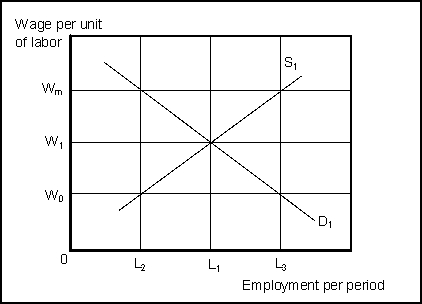A) marginal revenue.
B) marginal cost.
C) additional revenue product.
D) marginal revenue product.
F) None of the above
Correct Answer

verified
Correct Answer
verified
Multiple Choice
Use the following to answer question(s) : The Minimum Wage
 -(Exhibit: The Minimum Wage) Instituting a minimum wage causes a _______ of workers amounting to _______ workers.
-(Exhibit: The Minimum Wage) Instituting a minimum wage causes a _______ of workers amounting to _______ workers.
A) shortage; L₂-L₃
B) surplus; L₁-L₂
C) surplus; L₃-L₂
D) shortage; L₁-L₃
F) All of the above
Correct Answer

verified
Correct Answer
verified
Multiple Choice
Use the following to answer question(s) : The Minimum Wage
 -(Exhibit: The Minimum Wage) The total income received by the workers when the market is in equilibrium is:
-(Exhibit: The Minimum Wage) The total income received by the workers when the market is in equilibrium is:
A) W₂ times L₁.
B) W₁ times L₁.
C) W₀ times L₃.
D) W₀ times L₂.
F) A) and C)
Correct Answer

verified
Correct Answer
verified
Multiple Choice
A factor demand curve will shift because of:
A) a change in the price of a substitute factor.
B) the elasticity of demand for the final product.
C) the proportion of the factor's cost relative to total cost.
D) the slope of the MP curve.
F) A) and B)
Correct Answer

verified
Correct Answer
verified
True/False
Marginal product is obtained by multiplying the price of the product by the marginal revenue product.
B) False
Correct Answer

verified
Correct Answer
verified
True/False
If MRPL > MFCL, the firm should hire more labor.
B) False
Correct Answer

verified
Correct Answer
verified
True/False
All other things unchanged, an increase in income will increase the demand for leisure.
B) False
Correct Answer

verified
Correct Answer
verified
True/False
A change in labor demand will result from a change in the demand for the final product, a change in technology, and a change in the price of the labor.
B) False
Correct Answer

verified
Correct Answer
verified
Multiple Choice
Use the following to answer question(s) : 
 -(Exhibit: Marginal Revenue Product and Demand) If the product price is $2 per unit and the price of the factor of production is $60 per unit, the profit-maximizing quantity of the factor is _______ units.
-(Exhibit: Marginal Revenue Product and Demand) If the product price is $2 per unit and the price of the factor of production is $60 per unit, the profit-maximizing quantity of the factor is _______ units.
A) 0
B) 2
C) 4
D) 6
F) All of the above
Correct Answer

verified
Correct Answer
verified
Multiple Choice
The Case in Point on Airline Pilots indicated that a decreased wage for some pilots resulted in:
A) a decreased quantity of labor supplied because the substitution effect was the only relevant factor in this situation.
B) an increased quantity of labor supplied because the substitution effect was the only relevant factor in this situation.
C) a decreased quantity of labor supplied because the substitution effect dominated the income effect.
D) an increased quantity of labor supplied because the income effect dominated the substitution effect.
F) B) and C)
Correct Answer

verified
Correct Answer
verified
Multiple Choice
A lower wage:
A) has an income effect but not a substitution effect on the quantity of labor supplied.
B) means a higher income for any given level of labor supplied.
C) has an income effect which is always negative with respect to the quantity of labor supplied.
D) has an income effect which is always positive with respect to the quantity of labor supplied.
F) None of the above
Correct Answer

verified
Correct Answer
verified
Multiple Choice
Marginal revenue product is the:
A) change in total output resulting from a unit change in the quantity of a variable input.
B) change in total revenue resulting from a unit change in the quantity of a variable input.
C) change in total cost resulting from a unit change in the quantity of a variable input.
D) ratio of total revenue to the quantity of a variable input employed.
F) B) and D)
Correct Answer

verified
Correct Answer
verified
True/False
In a perfectly competitive labor market, the price of labor is equal to the marginal factor cost of labor.
B) False
Correct Answer

verified
Correct Answer
verified
Multiple Choice
Which of the following statements is true?
A) MRP = MP x MR
B) MRP = a one-unit change in a factor/change in total revenue.
C) MFC = change in total revenue/one-unit change in a factor.
D) MRP = change in the quantity of a factor times the price of the factor.
F) A) and D)
Correct Answer

verified
Correct Answer
verified
Multiple Choice
A leftward shift in the labor supply curve would result if:
A) people value leisure less highly.
B) people have more nonlabor income.
C) transit costs to and from work decline.
D) the population increases.
F) C) and D)
Correct Answer

verified
Correct Answer
verified
Multiple Choice
The price of an extra hour of leisure is:
A) $1.
B) the hourly wage rate.
C) the same as the price of money.
D) the total utility of labor.
F) A) and B)
Correct Answer

verified
Correct Answer
verified
Multiple Choice
The _______ effect of a _______ wage causes individuals to substitute _______ .
A) substitution, higher; labor for leisure
B) income; higher; labor for leisure
C) substitution; lower; labor for leisure
D) complementary; constant; leisure for labor
F) A) and B)
Correct Answer

verified
Correct Answer
verified
Multiple Choice
Use the following to answer question(s) : The Minimum Wage
 -(Exhibit: The Minimum Wage) Give a minimum wage of Wm, the loss in employment is _______ and the change in the wage is _______ .
-(Exhibit: The Minimum Wage) Give a minimum wage of Wm, the loss in employment is _______ and the change in the wage is _______ .
A) L₁-L₂; Wm-W₁
B) L₁-L₃; W₀-W₁
C) L₂-L₃; W₀-Wm
D) None of the above are correct.
F) C) and D)
Correct Answer

verified
Correct Answer
verified
True/False
Marginal factor cost is the change in total cost divided by the change in the quantity of the product.
B) False
Correct Answer

verified
Correct Answer
verified
Multiple Choice
If a firm is using a factor of production from a perfectly competitive market at a quantity of the factor where MFC = MRP, then profit:
A) is maximized.
B) can be increased by using less of the factor.
C) can be increased by using more of the factor.
D) can be increased by decreasing the factor price.
F) A) and D)
Correct Answer

verified
Correct Answer
verified
Showing 161 - 180 of 189
Related Exams